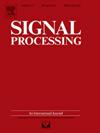Two non-convex optimization approaches for joint transmit waveform and receive filter design
IF 3.4
2区 工程技术
Q2 ENGINEERING, ELECTRICAL & ELECTRONIC
引用次数: 0
Abstract
This study presents two innovative approaches for jointly optimizing the radar transmit waveform and receive filter to improve the signal-to-interference-plus-noise ratio (SINR) for extended targets under signal-dependent interference. We operate under the assumption of incomplete information about the target impulse response (TIR), which is confined within a predefined uncertainty set. To ensure robustness against this uncertainty, we frame the problem as a max–min (worst-case) optimization. Additionally, we impose a constant modulus constraint (because it has the lowest possible peak-to-average power ratio (PAPR)) on the transmit waveform to guarantee our system operates close to saturation. To solve this, both approaches use a sequential optimization procedure, alternating between the transmit waveform and receive filter subproblems. The first approach employs the ADMM, decomposing each subproblem into a semi-definite programming (SDP) problem and a least squares problem with a fixed rank constraint, solvable via SVD. The second approach tackles the problem over two Riemannian manifolds: the sphere manifold for the receive filter and the product of complex circles for the transmit signal. By applying manifold optimization, the constrained problem is transformed into an unconstrained one within a restricted search space. The max–min problem is reformulated as a minimization problem, yielding a closed-form expression involving log-sum-exp. This is solved using the Riemannian conjugate gradient descent (RCG) algorithm, which builds on Euclidean conjugate gradient descent and utilizes the manifold’s properties, such as the Riemannian metric and retraction. Our numerical results demonstrate the robustness and effectiveness of these methods across various uncertainty sets and target types.
联合发射波形和接收滤波器设计的两种非凸优化方法
本文提出了两种联合优化雷达发射波形和接收滤波器的创新方法,以提高信号依赖干扰下扩展目标的信噪比(SINR)。我们在目标脉冲响应(TIR)信息不完全的假设下进行操作,目标脉冲响应被限制在一个预定义的不确定性集合中。为了确保对这种不确定性的鲁棒性,我们将问题构建为最大-最小(最坏情况)优化。此外,我们在发射波形上施加了恒定模量约束(因为它具有最低的峰值平均功率比(PAPR)),以保证我们的系统运行接近饱和。为了解决这个问题,两种方法都使用顺序优化过程,在发射波形和接收滤波器子问题之间交替进行。第一种方法采用ADMM,将每个子问题分解为一个半确定规划(SDP)问题和具有固定秩约束的最小二乘问题,通过SVD可解。第二种方法处理两个黎曼流形上的问题:接收滤波器的球面流形和发射信号的复圆积。通过流形优化,将约束问题转化为约束搜索空间内的无约束问题。最大-最小问题被重新表述为最小化问题,得到一个包含log-sum-exp的封闭表达式。该算法建立在欧几里德共轭梯度下降的基础上,利用流形的黎曼度量和回缩等特性,采用黎曼共轭梯度下降(RCG)算法求解。我们的数值结果证明了这些方法在各种不确定性集和目标类型上的鲁棒性和有效性。
本文章由计算机程序翻译,如有差异,请以英文原文为准。
求助全文
约1分钟内获得全文
求助全文
来源期刊

Signal Processing
工程技术-工程:电子与电气
CiteScore
9.20
自引率
9.10%
发文量
309
审稿时长
41 days
期刊介绍:
Signal Processing incorporates all aspects of the theory and practice of signal processing. It features original research work, tutorial and review articles, and accounts of practical developments. It is intended for a rapid dissemination of knowledge and experience to engineers and scientists working in the research, development or practical application of signal processing.
Subject areas covered by the journal include: Signal Theory; Stochastic Processes; Detection and Estimation; Spectral Analysis; Filtering; Signal Processing Systems; Software Developments; Image Processing; Pattern Recognition; Optical Signal Processing; Digital Signal Processing; Multi-dimensional Signal Processing; Communication Signal Processing; Biomedical Signal Processing; Geophysical and Astrophysical Signal Processing; Earth Resources Signal Processing; Acoustic and Vibration Signal Processing; Data Processing; Remote Sensing; Signal Processing Technology; Radar Signal Processing; Sonar Signal Processing; Industrial Applications; New Applications.
 求助内容:
求助内容: 应助结果提醒方式:
应助结果提醒方式:


